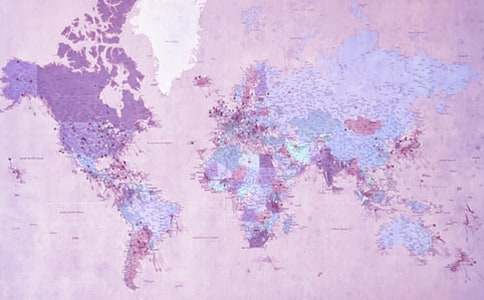- 相关推荐
桃儿七形态与生理特征的地理变异及种子萌发生理
【摘要】 桃儿七是小檗科鬼臼亚科桃儿七属一种多年生草本植物,因体内所含鬼臼毒素可作为前体用于合成抗癌药物而被人们大规模的无限制的滥挖滥采,植物资源及其生境都遭到了严重破坏,已被作为国家三级保护物种列入《中国珍稀濒危植物名录》,并被《中国植物红皮书》收录。本研究从保护生物学的角度出发,从桃儿七的个体形态特征、种实形态特征、光合作用特征等的地理变异及其种子的萌发特性等方面对桃儿七的一些生物学特性进行了研究。1.桃儿七的表型性状无论在居群内还是居群间都出现了不同程度的分化,且居群间的分化大于居群内的分化,即桃儿七的形态特征在物种水平上有着丰富的变异。但桃儿七形态特征在整体水平上表现为分化的无序性,表明桃儿七的形态变异是各种环境因子和内部遗传因素综合作用的结果。2.桃儿七种子产量较大,每果种子数随纬度的增加而增多,单粒种重随着纬度的增加而逐渐降低的,且这两性状在不同居群间已达到了显著性差异(P<0.05)。这是桃儿七在不同生境条件下对不同生活史策略的选择结果。每果种子数与单粒种重之间表现出了很弱的负相关(r=-0.1659,p=0.134)。总的来看,对桃儿七来说,较大的果实含较多比较小的种子,而较小的果实具有较少但较大的种子。3.桃儿七种子的生活力及萌发率(92%)都很高。虽然外界因素对种子内CAT、SOD和脱氢酶、淀粉酶等的活性存在不同程度的抑制或增强,但其对桃儿七种子最终的萌发结果影响不大。致密的种皮、果皮内容物以及种胚的发育和生理等并不是引起桃儿七种子休眠的主要原因。所以,桃儿七种子是否真的存在休眠,若存在,引起其休眠的具体原因又是什么,仍需进一步的实验研究来说明。4.桃儿七是一种介于阳生和阴生植物之间的耐阴植物,但不同地区的个体耐阴性也不太相同,中部和南部地区的桃儿七应该更适合在较为阴蔽的地段生长,而北部地区的则更适于生活在光照状况较好的环境中。且不同地区桃儿七在PFD-Pn响应和CO_2-Pn响应过程等方面已经有了较大的变异,各项光合参数差别较大。表明随时间的推移,生活在不同生境中的桃儿七不仅在形态等方面发生了适应性变化,在光合生理方面也同样发生了变异。且这种变异是由于不同桃儿七居群间的遗传分化所致。5.根据我们的初步研究和观察,认为引起桃儿七种群更新困难、面临濒危的原因与过渡采挖、鸟类和鼠类等对果实的摄食、营养生长期长、种子不耐贮藏且萌发缓慢、生境破碎化严重等有关

【Abstract】 Sinopodophyllum hexandrum is an endangered species, which is resulted from human abusing exploration due to its commercial application on synthesis of precursor of anticancerogen. Here, for the purpose of conservation biology, this paper mainly researches its morphological characteristic, seed characteristic, photosynthetic trait on the geographical variation and its seed germination.1. Diversity is existed in both between and among populations in phenotype of S. hexandrum. Differention between populations is more than that of member among population, which indicated a varying variation on the level of species. However, differential randomness on whole is shown on its morphological characteristic, which indicated that its morphological variations result from environment factors and genetic factors in itself, but both factors are not real reason of geo-environmental regularity variation and which also shows a young species.2. S. hexandrum can produced greater seed and seed number per fruit increases with increasing latitude, while per seed weight decreased with the increasing the latitude and these two traits in different populations had a significant difference (P <0.05). That is different life history strategy of choice results in S. hexandru in different habitats. The correlation between the number of seeds per fruit species and single-grain weight shows a weak negative correlation (r =- 0.1659, p = 0.134). All in all, for S. hexandrum, the larger fruit contained smaller seeds smaller, or vice versa.3. Seed viability of S. hexandrum and germination rate is high. Although the effects of external environmental factors on the seeds catalase (CAT), superoxide dismutase (SOD), dehydrogenases and amylase activities showed inhibition or enhancement activity; however, little influence was taken place on its seeds germination. Dense seed coat, pericarp contents, and embryo development are not main reason of seed dormancy. Therefore, further research is performed to find the real reason of its seed dormancy.4. S. hexandrum is a shade-tolerant species between sun plant and shade plant, but their shade-tolerance is different among individuals from each region: S. hexandrum from the middle and the south areas are supposed to be suitable to grow in shady areas, the northern individuals are more adaptive to grow in the better light conditions. Farther more, the response course to photon flux density (PFD) and CO_2 concentration of S. hexandrum from different distribution areas exhibited biggish difference, all the photosynthetic parameters were different distinctly. These indicate that S. hexandrum growing in different habitat have formed adaptive change not only in their morphology but also photosynthetic physiology, and these variations are caused by genetic divergence among populations.5. To our best knowledge, the reason resulted in the endangered population are listed as follows: (1) over-exploration activity and environmental degradation; (2) animal's predatory behavior; (3) the longer vegetative growth stage; (4) slowly seed germination; (6) serious habitat fragmentation.
【关键词】 濒危植物; 桃儿七; 地理变异; 种子萌发
【Key words】 endangered plant; Sinopodophyllum hexandrum; geographical variation; seed germination
桃儿七形态与生理特征的地理变异及种子萌发生理
中文摘要 3-5
ABSTRACT 5-6
第一章 文献综述 11-22
1 濒危植物保护生物学研究 11-12
2 表型变异研究概况 12-14
3 桃儿七研究进展 14-20
3.1 地理分布范围及分布格局的生态适应性 15-16
3.2 形态特征及其营养器官的解剖学特点 16-17
3.3 系统位置 17-18
3.4 发育生物学 18-19
3.5 繁殖生物学 19
3.6 化学成分及药用开发 19-20
3.7 化学成分的生态适应性 20
3.8 遗传多样性 20
4 本文研究内容 20-22
第二章 桃儿七体形态变异初步研究 22-37
1 材料和方法 23-24
1.1 材料 23
1.2 方法 23-24
2 结果和分析 24-35
2.1 不同居群桃儿七形态指标的统计分析 24-28
2.1.1 桃儿七形态特征变异状况分析 26-27
2.1.2 不同居群间桃儿七形态特征差异显著性分析 27-28
2.2 桃儿七形态特征的Mantel检验 28
2.3 桃儿七形态特征间的相关性分析 28-29
2.4 桃儿七形态特征与经纬度和海拔的相关性分析 29-30
2.5 聚类分析 30-34
2.5.1 对实体的聚类分析 30-33
2.5.1.1 居群水平上的聚类分析 30-31
2.5.1.2 个体水平上的聚类分析 31-33
2.5.2 对性状的聚类分析 33-34
2.6 桃儿七形态特征的主因子分析 34-35
3 讨论 35-37
第三章 桃儿七种实形态变异初步研究 37-48
1 材料和方法 38-39
1.1 野外调查与取样 38
1.2 形态指标测定 38
1.3 数据处理 38-39
2 结果分析 39-43
2.1 不同居群间种子及果实的形态特征变化 39-41
2.2 同一居群不同单株种子及果实的形态特征变化 41-42
2.3 桃儿七种子及果实形态特征间的相关性分析 42-43
2.4 桃儿七种子及果实形态特征与纬度和海拔间的相关性分析 43
3 讨论 43-48
第四章 桃儿七光合生理特性的地理变异 48-59
1 材料和方法 48-51
1.1 试验材料 49
1.2 测定方法 49-50
1.2.1 光响应(PFD-Pn)曲线测定 50
1.2.2 CO2响应(CO2-Pn)曲线测定 50
1.2.3 叶绿素含量的测定 50
1.3 数据分析 50-51
2 结果 51-56
2.1 不同种源桃儿七光合作用的PFD-Pn响应比较 51-52
2.2 不同种源桃儿七光合作用的CO_2-Pn响应比较 52-53
2.3 不同种源桃儿七蒸腾速率(Tr)和瞬时水分利用效率(WUE)的光响应曲线 53-54
2.4 不同种源桃儿七气孔导度(Gs)、蒸腾速率(Tr)、瞬时水分利用效率(WUE)的CO_2响应曲线 54-55
2.5 不同种源桃儿七叶绿素含量的比较 55-56
3 讨论 56-59
第五章 桃儿七种子萌发研究 59-70
1 材料和方法 59-62
1.1 试验材料 60
1.2 试验方法 60-62
1.2.1 种子千粒重的测定 60
1.2.2 种子生活力的测定 60
1.2.3 种子吸水速率的测定 60
1.2.4 种子发芽率的测定 60-61
1.2.5 种子萌发过程中生理指标的测定 61
1.2.6 土壤播种后的种子萌发试验 61-62
2 结果 62-67
2.1 种子千粒重 62
2.2 种子的生活力 62
2.3 种子的吸水速率 62-63
2.4 种子的萌发 63-64
2.5 种子萌发过程中的生理生化变化 64-66
2.5.1 脱氢酶和淀粉酶活性 64-65
2.5.2 抗氧化酶活性 65-66
2.5.3 可溶性蛋白和脯氨酸含量 66
2.6 土壤播种后的种子萌发试验结果 66-67
3 讨论 67-70
第六章 桃儿七致危因素及保护对策 70-73
1 濒危现状 70
2 致危原因 70-71
3 保护对策及有关保护对策的研究展望 71-73
参考文献 73-84
攻读硕士学位期间取得的学术成果 84-85
致谢 85
【桃儿七形态与生理特征的地理变异及种子萌发生理】相关文章:
玉米种子图像形态特征的提取03-07
种子萌发的条件”演示实验改进03-16
再谈“共同美”的生理心理基础03-19
瘦素与临床疾病的病理生理关系03-07
黄瓜生理性病害的防治技术03-25
腹膜的解剖及其生理功能03-20
探讨赤霉素浸种对沙冬青种子萌发的影响03-27
探析赤霉素浸种对沙冬青种子萌发的影响03-26
浅探黄瓜生理性病害的防治技术03-18